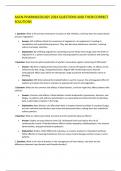AACN-PHARMACOLOGY 2024 QUESTIONS AND THEIR CORRECT
SOLUTIONS
1 Question: What is the primary mechanism of action of ACE inhibitors, and how does this impact blood
pressure regulation?
• Answer: ACE inhibitors block the conversion of angiotensin I to angiotensin II, leading to
vasodilation and reduced blood pressure. They also decrease aldosterone secretion, reducing
sodium and water retention.
• Explanation: By inhibiting angiotensin-converting enzyme (ACE), these drugs lower the levels of
angiotensin II, a potent vasoconstrictor, thus reducing systemic vascular resistance and lowering
blood pressure.
2 Question: How does the pharmacokinetics of warfarin necessitate regular monitoring of INR levels?
• Answer: Warfarin is highly protein-bound and has a narrow therapeutic index. Its effects can be
influenced by diet, drugs, and genetic factors. Regular INR monitoring ensures that the
anticoagulant effect stays within the therapeutic range to prevent thromboembolic events or
bleeding.
• Explanation: INR (International Normalized Ratio) is used to measure the anticoagulant effect of
warfarin and adjust the dose to maintain an appropriate level of anticoagulation.
3 Question: What are the common side effects of beta-blockers, and how might they affect patients with
asthma?
• Answer: Common side effects of beta-blockers include bradycardia, hypotension, dizziness, and
fatigue. In patients with asthma, beta-blockers can exacerbate bronchoconstriction by blocking
beta-2 adrenergic receptors in the lungs.
• Explanation: Beta-blockers can affect both beta-1 receptors (heart) and beta-2 receptors (lungs),
and non-selective beta-blockers may induce bronchoconstriction, making them less suitable for
asthma patients.
4 Question: Why are statins prescribed, and what are their potential adverse effects?
• Answer: Statins are prescribed to lower LDL cholesterol levels and reduce the risk of
cardiovascular events. Potential adverse effects include myopathy, rhabdomyolysis, liver enzyme
abnormalities, and gastrointestinal symptoms.
• Explanation: Statins inhibit HMG-CoA reductase, an enzyme involved in cholesterol synthesis.
While effective in lowering cholesterol, they can cause muscle damage and liver issues in some
patients.
5 Question: What is the role of diuretics in the management of heart failure, and what are the
differences between loop diuretics and thiazide diuretics?
, • Answer: Diuretics help reduce fluid overload in heart failure patients by promoting urine output.
Loop diuretics (e.g., furosemide) are potent and act on the ascending loop of Henle, while
thiazide diuretics (e.g., hydrochlorothiazide) act on the distal convoluted tubule and are less
potent.
• Explanation: Loop diuretics are used for more severe fluid overload due to their strong diuretic
effect, whereas thiazides are often used for mild to moderate conditions and can be combined
with other antihypertensives.
6 Question: How do proton pump inhibitors (PPIs) work to reduce gastric acid secretion, and what long-
term risks are associated with their use?
• Answer: PPIs inhibit the proton pump (H+/K+ ATPase) in the gastric parietal cells, reducing
gastric acid secretion. Long-term use can lead to risks such as Clostridium difficile infection, bone
fractures, and nutrient malabsorption.
• Explanation: By blocking the final step of acid production, PPIs effectively reduce stomach
acidity, but their prolonged use can alter gut flora and interfere with the absorption of calcium
and magnesium.
7 Question: What is the mechanism of action of metformin, and how does it differ from insulin in the
management of type 2 diabetes?
• Answer: Metformin decreases hepatic glucose production and improves insulin sensitivity.
Unlike insulin, which directly increases glucose uptake into cells, metformin works primarily by
decreasing glucose output from the liver.
• Explanation: Metformin is an oral hypoglycemic agent that does not cause insulin release
directly but enhances the body's response to insulin, whereas insulin is a direct glucose-
regulating hormone.
8 Question: In the context of antimicrobial therapy, how does the spectrum of activity of penicillins
compare to that of cephalosporins?
• Answer: Penicillins have a narrower spectrum of activity primarily against gram-positive
bacteria, while cephalosporins have a broader spectrum that includes both gram-positive and
gram-negative bacteria, with varying coverage depending on the generation.
• Explanation: Cephalosporins are classified into generations, with each successive generation
having improved activity against gram-negative organisms and, in some cases, increased
resistance to beta-lactamases.
9 Question: What are the key differences between the pharmacokinetics of intravenous (IV) and oral
administration of medications?
• Answer: IV administration provides immediate drug delivery into the bloodstream with 100%
bioavailability, whereas oral administration involves absorption through the gastrointestinal
tract, leading to variable bioavailability due to first-pass metabolism.




